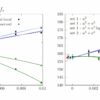Physicists have discovered “stacked pancakes of liquid magnetism” that may account for the strange electronic behavior of some layered helical magnets.
The materials in the study are magnetic at cold temperatures and become nonmagnetic as they thaw. Experimental physicist Makariy Tanatar of Ames National Laboratory at Iowa State University noticed perplexing electronic behavior in layered helimagnetic crystals and brought the mystery to the attention of Rice theoretical physicist Andriy Nevidomskyy, who worked with Tanatar and former Rice graduate student Matthew Butcher to create a computational model that simulated the quantum states of atoms and electrons in the layered materials.
Magnetic materials undergo a “thawing” transition as they warm up and become nonmagnetic. The researchers ran thousands of Monte Carlo computer simulations of this transition in helimagnets and observed how the magnetic dipoles of atoms inside the material arranged themselves during the thaw. Their results were published in a recent study in Physical Review Letters.
At a submicroscopic level, the materials under study are composed of thousands of 2D crystals stacked one atop another like pages in a notebook. In each crystal sheet, atoms are arrayed in lattices, and the physicists modeled quantum interactions both within and between sheets.
“We’re used to thinking that if you take a solid, like a block of ice, and you heat it up, eventually it will become a liquid, and at a higher temperature, it will evaporate and become a gas,” said Nevidomskyy, an associate professor of physics and astronomy and member of the Rice Quantum Initiative. “A similar analogy can be made with magnetic materials, except that nothing evaporates in a true sense of the word.”
“The crystal is still intact,” he said. “But if you look at the arrangement of the little magnetic dipoles—which are like compass needles—they start out in a correlated arrangement, meaning that if you know which way one of them is pointing, you can determine which way any of them points, regardless how far away it is in the lattice. That is the magnetic state—the solid in our analogy. As you heat up, the dipoles eventually will become completely independent, or random, with respect to one another. That’s known as a paramagnet, and it is analogous to a gas.”
Nevidomskyy said physicists typically think of materials either having magnetic order or lacking it.
“A better analogy from the classical viewpoint would be a block of dry ice,” he said. “It kind of forgets about the liquid phase and goes straight from ice into gas. That’s what magnetic transitions are usually like in the textbooks. We are taught that you start with something correlated, let’s say a ferromagnet, and at some point the order parameter disappears, and you end up with a paramagnet.”
Tanatar, a research scientist at Ames’ Superconductivity and Magnetism Low-Temperature Laboratory, had found signs that the transition from magnetic order to disorder in helical magnets was marked by a transitory phase in which electronic properties, like resistance, differed by direction. For instance, they might differ if they were measured horizontally, from side to side, as opposed to vertically from top to bottom. This directional behavior, which physicists call anisotropy, is a hallmark of many quantum materials like high-temperature superconductors.
“These layered materials don’t look the same in the vertical and horizontal directions,” said Nevidomskyy. “That’s the anisotropy. Makariy’s intuition was that anisotropy was affecting how magnetism melts in the material, and our modeling demonstrated that to be true and showed why it happens.”
The model showed that the material passes through an intermediate phase as it transitions from magnetic order to disorder. In that phase, dipole interactions are much stronger within sheets than between them. Moreover, the correlations between the dipoles resembled those of a liquid, rather than a solid. The result is “flattened puddles of magnetic liquids that are stacked up like pancakes,” Nevidomskyy said. In each puddle-like pancake, dipoles point roughly in the same direction, but that sense of direction varies between neighboring pancakes.
“It’s a bunch of atoms all with their dipoles pointing in the same direction,” Nevidomskyy said. “But then, if you go up one layer, all of them are pointing in a different random direction.”
The atomic arrangement in the material “frustrates” the dipoles and keeps them from aligning in a uniform direction throughout the material. Instead, the dipoles in the layers shift, rotating slightly in response to changes in neighboring pancakes.
“Frustrations make it difficult for the arrows, these magnetic dipoles, to decide where they want to point, at one angle or another,” Nevidomskyy said. “And to relieve that frustration, they tend to rotate and shift in each layer.”
Tanatar said, “The idea is that you have two competing magnetic phases. They are fighting each other, and as a result you have a transition temperature for these phases that is lower than it would be without competition. And in this competition scenario, the phenomena that lead to magnetic order are different from the phenomena when you don’t have this competition.”
Tanatar and Nevidomskyy said that while there’s no immediate application for the discovery, it may nevertheless offer hints about the still-unexplained physics of other anisotropic materials like high-temperature superconductors.
Despite the name, high-temperature superconductivity occurs at very cold temperatures. One theory suggests that materials may become superconductors when they are cooled in the vicinity of a quantum critical point, a temperature sufficient to suppress long-range magnetic order and give rise to effects brought about by strong quantum fluctuations. For example, several magnetic “parent” materials have been shown to harbor superconductivity close to a quantum critical point where magnetism disappears.
“Once you suppress the main effect, the long-range magnetic ordering, you may give way to weaker effects like superconductivity,” Tanatar said. “This is one of the leading theories of unconventional superconductivity. In our study, we show that you can do the same thing in a different way, with frustration or competing interactions.”
More information:
Matthew W. Butcher et al, Anisotropic Melting of Frustrated Ising Antiferromagnets, Physical Review Letters (2023). DOI: 10.1103/PhysRevLett.130.166701
Citation:
Physicists discover ‘stacked pancakes of liquid magnetism’ (2023, May 10)



